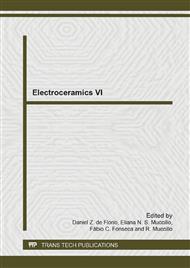p.29
p.36
p.42
p.50
p.56
p.61
p.69
p.75
p.81
Ultrasonic Synthesis of SrTiO3
Abstract:
Thermoelectric ceramics convert thermal into electrical energy, based on the Seebeck effect. In order to improve this energy conversion, the grain size of these ceramics must be in nanometric scale to reduce the thermal conductivity and electrical resistivity. Thus, nonconventional synthesis methods are being studied to produce nanoparticles, such as ultrasound synthesis technique (USS). These methods can produce powders with particles size lower than conventional synthesis, as compared to solid-state reaction (SSR), for example. In this study, strontium titanate (STO) based ceramics were synthesized by SSR and USS with 30, 40 and 50 minutes of ultrasound irradiation of 5W/ml power. The powders were characterized by X-ray diffraction (XRD) and scanning electron microscopy (SEM). There have been obtained powders of ~140nm crystallite size using USS method during 40minutes, which has proven to be the best ultrasound synthesis conditions i
Info:
Periodical:
Pages:
56-60
Citation:
Online since:
July 2014
Keywords:
Price:
Сopyright:
© 2014 Trans Tech Publications Ltd. All Rights Reserved
Share:
Citation:


